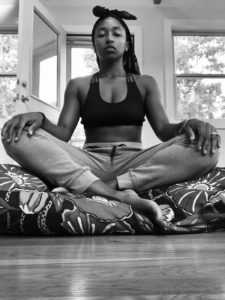Elevate The Mind

What is Meditation Exactly?
First, let me tell you what it is not…
It’s not a religion and it’s not used to escape reality. It’s not about being zoned out, absent of thought or even about giving up control of one’s mind. To me, meditation is about mindfulness. Intentionally, creating the time to focus your awareness on and pay attention to what your mind is doing right in the moment. Subsequently, achieving a mentally and emotionally calm, clear state of mind.
A few weeks ago, a good friend of mind re-posted this photo to her Instagram story. It is literally a live high-tech image of my mind before and after meditation.
Our brains are constantly active – I mean that’s its job, right? Controlling every function of our bodies; thoughts included. Seldom, do we take the time to be still and focus exclusively on our thoughts. Through the practice of meditation we are quieting the mind, which is key to our overall health. Practicing mediation daily has documented health benefits which include:
- Stress management
- Pain management
- Increased sense of harmony within social and physical surroundings
- Sleep better at night
- Improved work performance on task
- Improved awareness of mental capacities
- Increased sense of well-being
If you’re not screaming sign me up, you must have not read all of those benefits correctly!
There are many forms of meditation and believe it or not, most of us have practiced some form of it before – Zen, Mantra, Transcendental, Vipassana, Chakra, Qigong to name a few.
I was inspired to begin practicing meditation after reading the New York Times Best Seller, “The Four Agreements”, by Don Miguel Ruiz. Being a beginner to the practice, I began using and am now a strong advocate of Headspace https://www.headspace.com/invite/8bGBL > , the guided meditation app – where during each session you are provided with a brief explanation of how the mind behaves during meditation, you are guided through a particular meditation technique, and the session finishes with suggestions on how to integrate this technique into everyday life(Headspace,2019).
Will you incorporate meditation into your journey to operating at an elevated sense of well-being?
Edlin, Gordon, and Eric Golanty. Health & Wellness. 13th ed., Jones & Bartlett Learning, 2019
“What Are All the Types of Meditation & Which One Is Best?” Headspace, https://www.headspace.com/meditation/techniques.
The practice of mindfulness meditation gives us the opportunity to be more present with ourselves just as we are. Mindfulness is the basic human ability to be fully present, aware of where we are and what we’re doing, and not overly reactive or overwhelmed by what’s going on around us (Brantley, et al. 2019).
Want to try it?
Practice this 5-minute Mindfulness Meditation exercise that was shared during my certification studies.
Become comfortable:
Find a quiet place where you can sit in a chair. Sit straight, uncross your legs, place your feet flat on the floor. Place your hands in your lap and take two easy, deep breaths. Then breathe easily and naturally. Bring your shoulders down from your ears.
Step 1.
Focusing on the feet: Close your eyes for 10 seconds and focus your awareness on the sensation of the bottoms of your feet touching the insoles of your shoes. After you open your eyes, note what your mind was doing while your eyes were closed.
Step 2.
Focusing on the back: Close your eyes for 10 seconds and focus your awareness on the sensation of your back touching the chair. After a couple of seconds with your eyes closed, open your eyes, take an easy breath, and note what your mind was doing while your eyes were closed.
Step 3.
Focusing on the breath: Close your eyes for 10 seconds and notice your breathing. Don’t change your breathing rhythm or pattern, just notice the breath going in and out of your body.
Now you know three basic meditation postures: feet on the floor, back against the chair, and focus on the breath. With a bit of practice, you will discover the posture that is best for you.
Step 4. Focusing for 30 seconds, and then 90 seconds: Become comfortable (see above). Choose one of the three meditation postures. Close your eyes, and focus your awareness on your feet, back, or breathing for 30 seconds. While you’re meditating, if you notice your mind wandering, refocus your awareness on your feet, back, or breathing. When you think the 30 seconds has elapsed, open your eyes and take a breath.
(Edlin & Golanty 2019)
How do you feel? Mindful meditation reads to be simple, but once in practice it is not as easy. Do not feel discouraged if you find you were uneasy, your mind wandered, you laughed, or felt tired- these are all common reactions. Whenever you meditate, you can expect your mind to wander and to think. When you notice it does, acknowledge the emotion, then refocus your awareness on your feet, back, or breathing.
Try for 5 minutes every day consecutively for a week and share with us your feelings on mindfulness meditation.
Brantley, Jeffrey, et al. “How To Practice Mindfulness Meditation.” Mindful, 21 Oct. 2019, https://www.mindful.org/mindfulness-how-to-do-it/.
Edlin, Gordon, and Eric Golanty. Health & Wellness. 13th ed., Jones & Bartlett Learning, 2019.